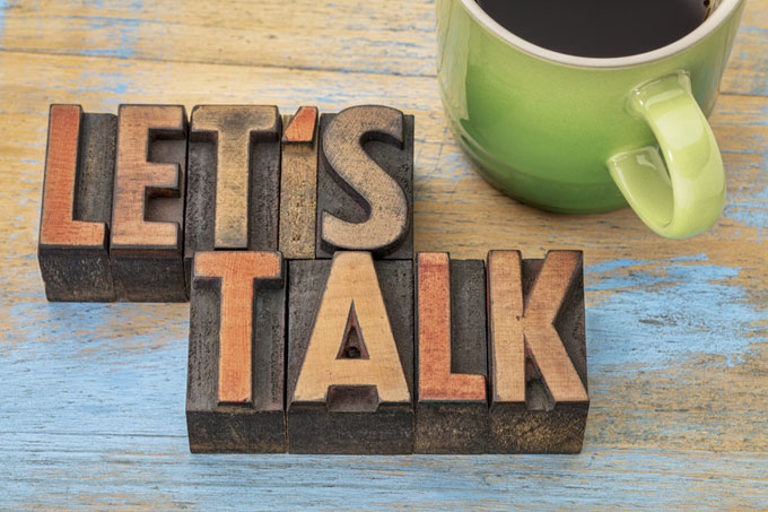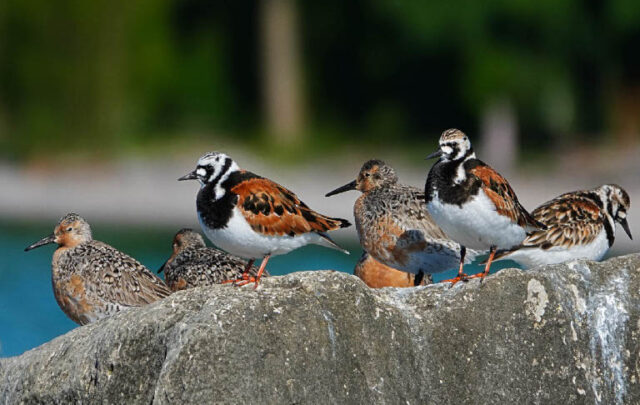Ed.note: On October 10, 2019 we’ll be hosting the live, online event, We Need to Talk, a conversation with Karin Kirk and Susanne Moser about how to talk about the climate crisis. Get your tickets here.
In the March for Science Facebook page, someone asked how group members might engage in productive conversation with a family member who holds opposite ideologies. The query immediately prompted hundreds of comments and suggestions, with the tally increasing by the minute.
The surge of responses underscores growing concern with scientific/political stalemate. The notion of a magic bullet to reach people is deeply tantalizing, but alas there is no simple answer: Connecting with someone takes thoughtful effort and humility.
But what follows is one example of a dialogue that played out in a surprising and encouraging way. People can change their outlooks, if they strive to build trust and listen to each other. Consider the path taken by Brenda Alfred and Heidi Steltzer in their conversation about common ground on climate change.
‘Seeing how different a conversation can be …’
“We call ourselves senior millennials,” quips Brenda Alfred, 69, referring to a lifestyle that doesn’t abide idle time. She raised “four and a half kids … five if you count my husband,” and then began college at age 38. “It’s something I always wanted to do, but in a small town, everybody doesn’t get to go to college,” Alfred explains. “I had my brain expanded considerably.”
Alfred retired in 2014, but downtime didn’t suit her. “I had gotten really lazy,” she says. “So I found a reason to go back to work.” She now works as a part-time medical file clerk at a drug rehab facility, where she continues to learn.
Alfred has close ties to her Manistee, Michigan, community, and she’s concerned about environmental damage to Lake Michigan. But not so much with climate change, which she says “has not been traced back far enough.” She rates herself as “cautious” on the Global Warming’s Six Americas scale.
Heidi Steltzer, 45, is an environmental scientist who studies climate change in the Arctic. She looks about two decades younger, bundled up in a scarf and cozy vest in her Durango, Colorado, home office. “I thought I wanted to be an oceanographer, but then I got seasick,” she muses, putting a swift end to any illusion that she’s an invincible, know-it-all scientist. Steltzer is an associate professor of biology at Fort Lewis College. She has an impressive list of academic credentials, but comes across as relatable and disarming.
Alfred and Steltzer have come together to talk about climate change. Their conversation is part of a series of interviews that pairs people with different views for a discussion about science, policy, and values. This conversation took place in late October via a live video call. (Read the previous article about common ground in climate change dialogue.)
“I’ve been yelled at by other climate change scientists, so I’m excited for the opportunity to see how different a conversation can be,” explains Steltzer, as the two settle in to exchange viewpoints.

A dialogue rooted in shared values
Despite their apparent differences, Alfred and Steltzer see eye-to-eye on several issues. Prior to their interactions, each had answered questions about her views of environmental resources, regulations, scientists, and corporations. Their responses suggested they agree that corporations should have a minimal role in setting policy, and that humans are having a negative impact on the Earth. In fact, Alfred scores as being more concerned than Steltzer when it comes to stewardship of caring for Earth’s resources: “As Christians, we’ll be held responsible for preserving [the Earth] or trashing it,” Alfred says, adding, “This has to start individually.”

While Steltzer has devoted her career to understanding environmental issues, her responses to the values questions reflect a diverse set of beliefs. She feels she is safe from the worst effects of climate change, but acknowledges that many people are vulnerable. She says that the media exaggerate environmental problems, even though she knows these problems are real and serious.
The biggest gap between Alfred and Steltzer is in their trust of scientists, where each was pegged at opposite ends of the spectrum.
“A lot of data can be skewed,” Alfred says, “I know that scientists are supposed to be impartial, but I think that some of them do have an agenda.”
Steltzer readily acknowledges that the scientific community can do more to ease this concern. “We haven’t shared science in ways that build trust,” she explains. “If we’re going to ask other people to change, we need to change first ourselves. That’s something I’ve taken to heart.”
Lessons learned from a story of lost lakes
Steltzer exemplifies trust-building as she shares experiences from her Arctic research. This past summer, she worked with a Yupik Eskimo student and other researchers to study “drained lakes” in the Alaskan tundra. As permafrost beneath the lakes melts, water slips away into the subsurface, leaving behind a dry lakebed.
Far from the traditional scientific discourse, Steltzer infuses her tale with palpable details of the “mushy, squishy tundra,” and the humility she felt working with a Yupik native. While working in the field, Steltzer realized the Yupik student’s observations of the changing landscape were more honed than her own.
Alfred engages with the story, asking for more information. “How do the lakes get lost?”
While Steltzer and her team say they know the basic reasons, they haven’t yet pinned down the exact timing and mechanics of the disappearing water. She has collected willow samples, but as yet is unable to bring the samples to the lab. “To be honest, we don’t have the money to complete the analysis.”
Alfred is sympathetic: “I would be interested to know what you find out, once you have the time and the funds to figure it out.”
“Okay!” replies Steltzer cheerfully.
“It’s fascinating,” Alfred says.
‘Are we making things worse?’
With rapport between Alfred and Steltzer mounting, Alfred takes advantage of the opportunity to have the ear of a climate scientist. “Heidi, what has the greatest effect on climate change?” she asks. “Are we making things worse by what we do?”
Steltzer uses an analogy of a dance party to describe the vibrational energy of greenhouse gases as they trap heat in the atmosphere. “The energy the Earth radiates can make carbon dioxide dance,” she explains, throwing in a few disco moves as she speaks.
But Steltzer shifts from amusing analogy to sobering reality: “Temperatures are changing more rapidly than any time we have data for. A little bit warmer isn’t all that scary. But if it’s too fast we won’t be able to keep up.”
“Okay,” Alfred says, digesting the information and then reflecting it back to Steltzer, “So you’re concerned about the rapid changes.” Alfred then parses that insight with her own experiences. “I’m in an area that is less dramatically affected by climate change. I don’t think Michigan’s ever been a dust bowl. It all just ebbs and flows. We just roll with it. We don’t think about it in drastic terms.”
Alfred explains that people in her area may not feel acute effects of climate change, “All this information needs to be shared, because a lot of people don’t care. This has to be presented to people like us to convince us that there is an impact.”
Regulation is a ‘dirty word … government over-involvement’
Throughout the conversation, Alfred makes references to the concept of individual responsibility when it comes to taking care of the environment. While that is a sensible starting point, she wonders, are individual actions a sufficient response to large sources of pollution?
“I don’t like regulations. To me, that’s a dirty word,” Alfred says, flatly. “It’s government over-involvement.”
But when asked to consider an example of a nearby oil spill, Alfred has a different perspective. In 2010, a pipeline owned by Enbridge released 840,000 gallons of tar sands oil into a tributary of the Kalamazoo River. The ruptured pipeline continued to flow for 17 hours, soiling a 40-mile stretch of the river with bitumen, a dense form of crude oil that’s notoriously stubborn to clean up. Investigations of the accident revealed “pervasive organizational failures at Enbridge.”
“That had a real direct personal impact on me,” Alfred says, as she recalls the spill and cleanup efforts. “Somebody like Enbridge needs to be scrutinized.” She catches her own turnabout, “And here I am talking about an agency that needs to do that.”
Alfred searches for a way forward, caught between her dislike for regulation and her own experience with an environmental calamity, caused in part by what is widely seen as corporate carelessness. “I don’t know how closely these companies are scrutinized. There’s that corporate greed. They don’t care. We need to put pressure on them.”
“Yeah, I don’t know …” Alfred pauses, thinking. “We can’t boycott oil, we need to get our cars around … I’m not really sure. I am not the one with the answer.”
Alfred concludes: “I’m gonna leave it to you younger guys to do that.” She smiles, gesturing toward Steltzer on the screen, “You can do it, Heidi!”
‘My mind has changed …. This was cool!’
A key consideration in this “common ground” interview approach is that individuals can use perspectives outside their own to more quickly reach new solutions. Instead of drowning-out dissenting voices, can they listen to them, and use them to craft more inclusive policies that could garner broader support?
When asked how she might use the perspective gained from this conversation, Alfred acknowledges a shift in her views:
“I came into this evening with preconceptions. I’m very pleased that my mind has changed. I have a great deal of respect for you. I wouldn’t say, ‘Oh I spent an hour with a tree hugger.’ I would never say that again. I understand and I appreciated it. And I think it was because we had those couple areas of common ground. We may disagree about some things, but I also realize that I am capable of listening and learning. And you presented your information very well, and I think wherever you take your information, if you can present it like that, you are going to reach people and you are going to change minds.”
Steltzer beams and nods vigorously, “Thank you so much, Brenda. A thoughtful conversation is how I want to understand people’s perspectives on climate change,” she says, “not through conflict.”
Alfred seems energized by her new perspective and she reflects on the entire experience, “This was cool!”





